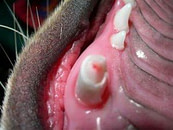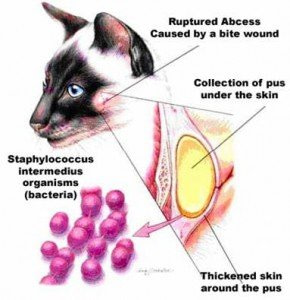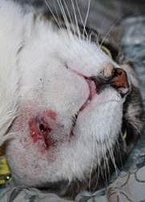Cats broken teeth and dribbling is the second in a series of articles specially researched and written for Siamese Cat Breeder relating to dental care and oral hygiene for cats by Sheila Calloway RVN.
Sheila is a qualified veterinary nurse and has over 30 years experience working with and keeping pets. Many of you will have seen Sheila at cat shows and she is usually found on the Siamese section with her cats.
Ouch – Cats Broken Teeth and Dribbling
If your cat has broken teeth then they may be in real pain and clever as they are they can’t speak English so it is up to us to understand there body language, behaviour and to spot things like changes in appetite and weight. A regular oral examination will also help us spot problem and if we find our cats have broken teeth we can then at least get them the help they need from our vets.
Poor diet, genetics, stress, and age all play a role in the development of feline dental problems. Some cats are genetically predisposed and may develop dental problems at a younger age and lack of a good oral hygiene regime for your cat will most certainly lead to problems.

Cats Broken Teeth
In cats, the canine and incisor teeth are frequently fractured from trauma. For most cats in general, the canine teeth are most likely to fracture from facial trauma while fractures of the pre-molar and molar teeth from simply chewing objects is quite rare; our felines have more sense than try and bite on something that is clearly too hard!
Do Cats Fractured Teeth Hurt?
It would be logical to think that cats will suffer pain from a fractured or broken tooth as we do.
The degree of pain is related to the extent and the duration of the fracture. If the inside of the tooth (pulp) is exposed from an initial injury such as a fall, there is immediate and excruciating pain. However, many owners fail to notice their cats have even fractured a tooth.

also known as a gum boil
As the tooth becomes infected through the fracture site, it may die and become less-painful – however this is rare and you should still consult advice from your vet.
If the infection spreads to the jaw (alveolar) bone supporting the tooth, pain often returns or increases significantly. The bone and local soft tissues may then become infected and eventually form an abscess. The abscess can look like a swelling inside the mouth (intraoral) or outside the mouth (extraoral).
Treatment for a Cats Broken Tooth
Most certainly a broken tooth will require a trip to the vets for your feline, extraction being the most effective and simplest treatment.
The sooner this transpires the better and reduces risk of complication of the injury such as pain, abscesses or weight loss because the suffering cat is unable to eat properly.

Oral Abscesses in Cats
A dental or oral abscess in cat’s is a serious condition.
A cat abscess needs to be treated immediately by a vet, as such an infection can cause other serious health problems including infected bone (osteomyelitis) or infected blood (toxemia) diseases.
Abscesses are localized collections of pus that are formed by tissue disintegration resulting from an infection; the abscess is surrounded by an inflamed, swollen area.
A tooth abscess in cat’s is a relatively common occurrence, especially in those cats that have periodontal disease or who have suffered some kind of physical trauma to their mouths such as a broken tooth or mouth burn – some cats seem to like to play and chew electric wires…!
Dental abscesses can form under and around teeth and in the gums
Symptoms of Dental Abscess in Cats
Cats can’t communicate their discomfort in words, so it is up to us to look for symptoms of a tooth abscess:
- Pawing at the mouth (indicating pain)
- A visible broken tooth
- Loose teeth
- A strongly discoloured tooth
- Becoming very quiet and subdued
- Irritability – unusual aggression towards owners or other pets
- Reluctance or inability to eat, resulting in weight loss
- Drooling
- Fever – excessive drinking and urinating
- Bleeding or discharge from the nasal region
- Discharge/watering from eyes
- Facial swelling
- An inflamed open wound on the gum, called a gum boil
- The appearance of a facial wound, usually along the jaw line, which will drain pus and blood.
- Foul smelling breath or mouth area
If your cat exhibits any of these symptoms, see a veterinarian as soon as possible. An untreated abscess in cats can lead to a systemic bacterial infection, tooth loss, and bone loss in the jaw.
Treatment of Abscesses for Cats
A vet will visually examine the cat’s mouth, but may also suggest x-rays to diagnose the extent and/or source of the infection.
If it’s a tooth, the vet may opt to treat the infection first with antibiotics and when the infection is under control extract the offending tooth.
Long-acting antibiotics injections tend to be the most effective treatment as trying to administer tablets to a cross feline with a sore mouth or lack of appetite can be unreliable, inconsistent or ineffective. Not recommended!
Removing fur from around an eternal abscess site will help reduce the risk of further or re-infection and assist with keeping the area clean.
For External Abscess Wounds the Vet Could Suggest
-
Gently cleaning the wound site with a mild diluted antiseptic solution or Epsom salts diluted in warm water two or three times a day to ensure the site is kept clean and free from further infection.
- Feed smaller amounts of softer foods more often until the abscess has healed and/or the inflammation has reduced and/or the pain or sensitivity has significantly gone.
- Ensure fresh drinking water is constantly available and changed frequently.
- Wash eating and drinking bowls thoroughly and replaced frequently.
- Wash any soiled bedding
Prevention of Abscesses in Your Cat
A broken tooth due to trauma is unfortunately largely unavoidable
However a good oral health regime to help take care of your cat’s teeth and mouth will certainly reduce the risk:
- Feeding your cat dry, hard “kibble” type food frequently, will help scrub off plaque and help prevent tartar from forming.
- Regularly checking the cat’s mouth for broken teeth, oral lesions, or unusually bad breath will facilitate an early intervention and treatment before the problem escalates. Please see Article 1: How to examine your cat’s mouth.
- Try to hide exposed electrical wiring if your cat is inclined to consider them to be tempting play toys!
Coming soon on Siamese Cat Breeder my next article is called ‘What a pong – bad breath and a smile without sparkle!‘
Please add your comments or any questions below and I will be happy to answer you.




My cat is 2 1/2 dentist says two front teeth are baby teeth that never came out, wants to take out, one of them bleeds when brushed, have you ever heard of this ?
Hi Pamela
Yes I have heard of this before it is not uncommon. Have you seen the first article that Sheila wrote? It includes a section devoted to this very subject. Check this link out and look for the section on ‘Double Dentistry’. – https://siamese-cat-breeder.co.uk/dental-care-for-cats/
Hope this help,
Ross
Hi Pamela
Yes ‘double dentistry’ is very common in both cats and dogs, where the baby or milk teeth do not fall out naturally, when the second, adult teeth start to erupt.
The bleeding gums when brushed may be indicative of inflamation or infection. Clearly it shouldn’t be happening as there is some sensitivity around the vulnerable area where your cat has two teeth that should no longer be there. In itself this could lead to further risk of oral health problems as your cat gets older.
I’m am certain that the advice your vet has given to extract the baby teeth is based on his professional expertise and knowledge and can be trusted to be the correct treatment for the problem.
However, if you have any concerns or doubts, please do discuss these with your vet – they are only too happy to answer your questions and provide any assurances you need.
I hope this is helpful and that your cat is soon completely well again.
Sheila